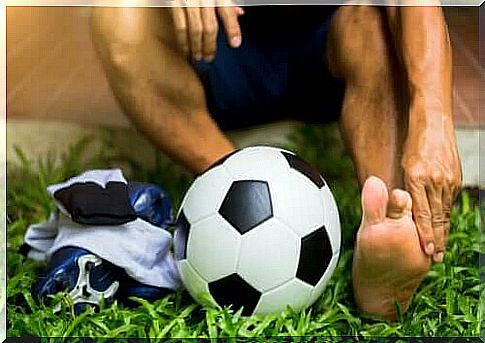Sprained Big Toe: Causes, Symptoms And Treatments

A sprained big toe is very common in football players. Sources we will review later estimate 5.4 cases of sprained big toes per season on some teams, meaning 0.062 patients per. 1000 active athletes. Specialists estimate that those affected lose an average of 10.1 usable sports days during recovery.
If we turn our attention to professional football players, we find that 45% of them have suffered from sprained big toes during their sporting careers. If you want to know more about this problem and how to deal with it effectively, you have come to the right place.
Anatomy of the foot and a sprained big toe
Before we review the damage that the article here is about, we need to examine the physiology of the parts involved. The human foot and ankle are true works of art in biomechanics that have a total of 33 joints, 26 bones and over 100 ligaments, tendons and muscle tissue.
In this case, we turn our attention to the first metatarsophalangeal joint. This is integrated into the functional and anatomical unit in the first radius of the foot, which makes up 75% of the plantar arch. This structure is key as its range of motion conditions the functionality of the entire foot.
The first metatarsal (big toe) and proximal phalanx form the metatarsophalangeal joint, which is damaged by a sprained big toe. This joint performs the impulse in the last phase of the gait, so it is not surprising that the problem is evident in athletes suffering from it.
What are the symptoms of a sprained big toe?
As we have said, it is a lesion in the underside of the foot, so the most common signs are pain when walking, intolerance to touching the affected area and local swelling.
In any case, we must note that there are several degrees of damage that condition the degree of severity. These are the following:
- I: This is a sprain in the underside of the foot. It produces local sensitivity and a slight inflammation.
- II: There is a partial tear in the underside of the foot. This causes more general soreness and pain, moderate swelling and bruising. The movement of the foot is painful and limited.
- III: A complete crack in the underside of the foot. The injury area is very painful, swollen and there are clear bruises. At this point, movement of the big toe is almost impossible.
Sprained big toe can develop acutely or gradually, depending on the type of trauma. If the injury occurs gradually, the injury worsens over time until the condition makes physical activity impossible.

The main causes of a sprained big toe
As stated by the portal EFORT Open Reviews, physical activity is the main cause of a sprained big toe. Among American football players, 45% of the interviewed players reported having suffered from the problem during their professional careers. The incidence is estimated at 0.062 cases per 1000 athletes at risk.
85 percent of these injuries occur on artificial turf. This is much harder than normal grass, so the resistance from the grass probably plays an important role in the damage.
Athletes who practice other sports also suffer from this medical condition. For example, it is estimated that 0.4% of rugby players suffer from sprained big toe every season. This injury accounts for 11% of all foot injuries in this demanding physical activity.
Mechanism of damage
Most injuries are due to repeated contact with the ground or a direct collision with another player. The events cause an axial load on the over-extended first metatarsophalangeal joint.
The force and the atypical position of the structure result in ligament damage of varying severity.
In addition to tendon damage, it can also affect the sesame bones. These bones become damaged or even broken, although there are usually previous injuries or problems that cause this injury.
Risk factors
As we have mentioned, a demanding sport on artificial turf is a clear predisposing factor. In any case, in addition to the terrain, any collision with another player (or fixed element) can cause the aforementioned load.
Below is a list of the sports that are considered the most risky in terms of this injury.
- American football or traditional football.
- Rugby.
- Basketball.
- Athletics: Running, jumping, obstacles.
- Dance.
Diagnostic tests
Doctors may suspect a sprain of the big toe joint during a physical examination. However, we need an X-ray of the bone structure, as indicated by the Stat Pearls portal. Bilateral X-rays of the foot are also important in assessing damage to sesame bones.
Magnetic resonance imaging is very useful in assessing damage to the sole of the foot. Clinical evidence depends on the extent of the injury and the patient’s condition.
Treatment of a sprained big toe
Regardless of the degree of injury, the first step is always to apply rest, ice, wrap, swelling. This method is based on the following principles:
- Keep your foot free from stress and use it as little as possible: The average recovery time in athletes is around 10 days, always in the case of a Class I injury. Grade II injuries take 4 to 6 weeks to recover, while grade III injuries only heal a month and a half later.
- Ice: It is always advisable to place ice packs on the affected area for 20 minutes three or four times a day.
- Cover: To avoid inflammation and pain, we need an elastic compression bandage.
- Swelling: If the patient is able to do so, it is best to rest with the leg raised above the level of the heart.
Even grade III injuries usually respond to conservative treatment, although the recovery time is much longer. If the patient does not recover, they may need a surgical procedure: An operation on the sole of the foot.

Healing of a sprained big toe
As mentioned above, the recovery time varies from 10 days to several months depending on the degree of damage to the sole.
Moreover, in the most severe cases, the patient can never restore the original osteoarticular structure. This results in rheumatoid arthritis or stiffness in the big toe.
A sprained big toe is not serious
It is important to inform athletes about the possible risks of performing demanding exercises, especially if the activity is performed on a solid surface or in other cases if there is a high risk of collision.
We can prevent this type of injury, in part by performing exercises with the foot that help the structures involved achieve resilience. Footwear should also be appropriate and as soft as possible to protect the sole of the foot from injury.
In any case, we must not forget that these are normal and expected events. Fortunately, they are almost never a serious problem. With a few days of rest, ice and physiotherapeutic care, there is improvement after a few weeks.









